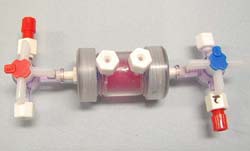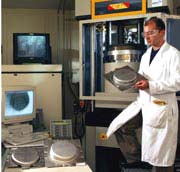This special field revolves around processes for modifying material properties (milling, cooling), composition (filtration, distillation) and type (oxidation, hydration).
Valuable information is available on a broad range of technologies including material separation, laser processes, measuring techniques and robot engineering in addition to testing methods and coating and materials analysis processes.

VTT Technical Research Centre of Finland and Lifa Air Oy Ltd have jointly developed a room filter that traps particles, toxic gases, bacteria and viruses in the incoming air. Low-priced and energy-efficient, the filter can be fitted in the existing air-conditioning systems. Room-specific filtering of inlet air has been attracting increasing international attention in the face of the possibility of a terrorist strike with chemical warfare agents introduced into the HVAC (Heating, Ventilating, and Air-

An industrial engineer at Purdue University has created a method to increase the efficiency, profitability and capacity of recycling operations for electronic products such as computers and television sets.
The work also promises to open up a new area of research in a field known as scheduling.
More than 1.5 billion pounds of electronic equipment is processed every year in the United States, and the quantity of discarded personal computers is expected to rise substantially over the

MIT engineers report a new approach to creating three-dimensional samples of human tissue that could push researchers closer to their ultimate goal: tissues for therapeutic applications and replacement organs. The technique could also help answer questions in cell and developmental biology.
The team “seeded” human embryonic stem cells, which have the potential to differentiate into a variety of specialized cells, onto a biodegradable polymer scaffold. By treating the scaffold/stem cell stru

Researchers at Oxford University’s Department of Engineering Science have recently made great lengths in both engineering and monitoring 3-dimensional tissue.
Engineering tissue involves the seeding of appropriate cells into a scaffold to form a bio-construct or matrix. The Oxford team has improved this process by developing a new kind of nutrient circulation and scaffold system for 3-D bulky tissue culture. The scaffold, made from biopolymers or synthetic polymers, has a network of capillar

Could impact fiber-optics, other industries
Assembling a machine sounds straightforward, but what if the components of that machine are nanoscopic? Similarly, bringing together the ends of two cables is simple unless those cables have a core diameter many times smaller than a human hair, as is the case with fiber optics.
Although there are devices on the market with similar credentials, they are expensive and have inherent limitations. Using a fundamentally new design, an MI

With new, one-of-a-kind test equipment, National Institute of Standards and Technology (NIST) researchers aim to stamp out costly, delay-causing errors in the design of dies used to make sheet-metal parts ranging from car hoods to airplane wings to pots, pans and cans.
The U.S. auto industry alone is estimated to spend more than $700 million a year on designing, testing, and correcting new dies for its latest models, each containing about 300 stamped parts shaped by dies and presses. About